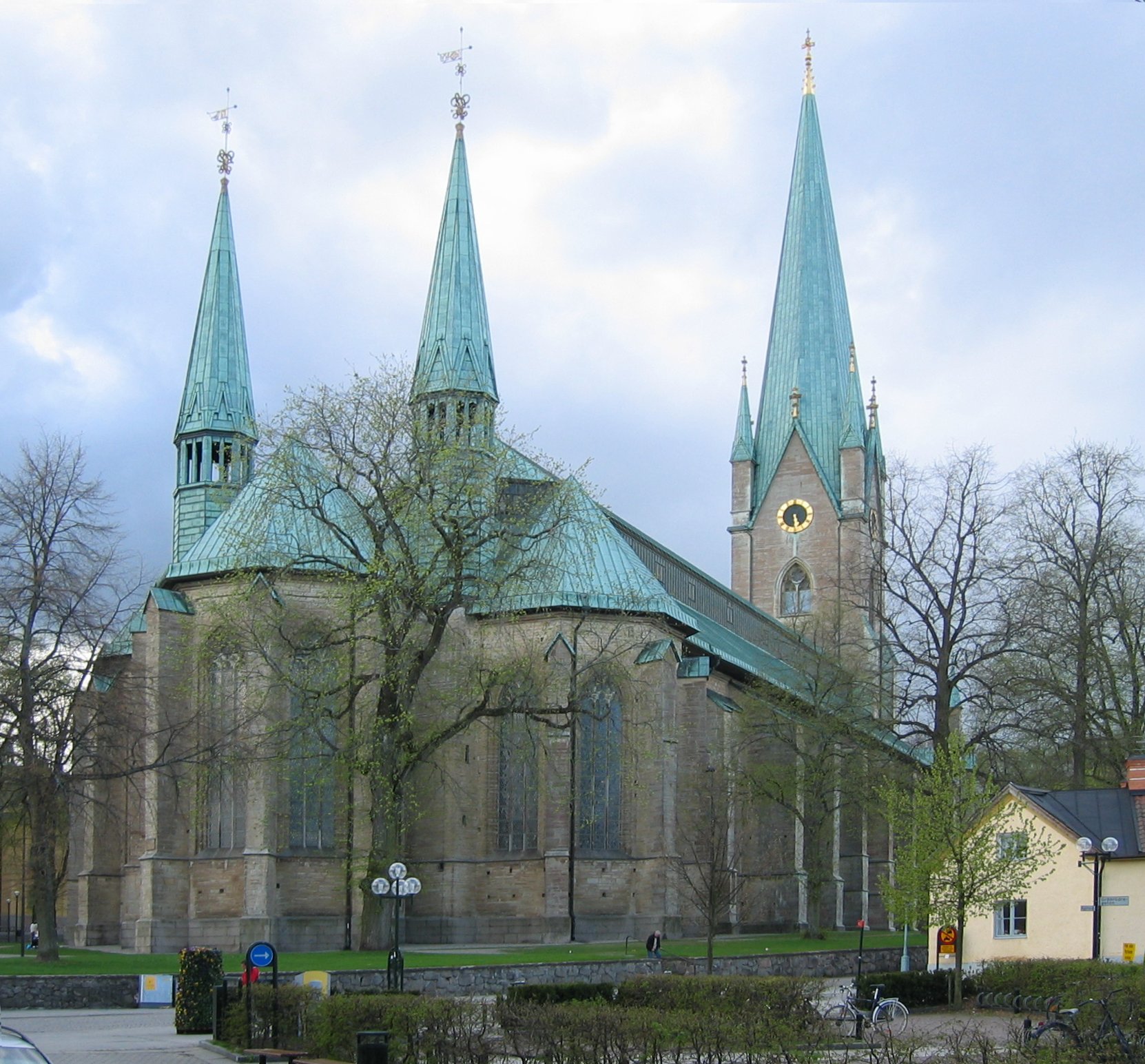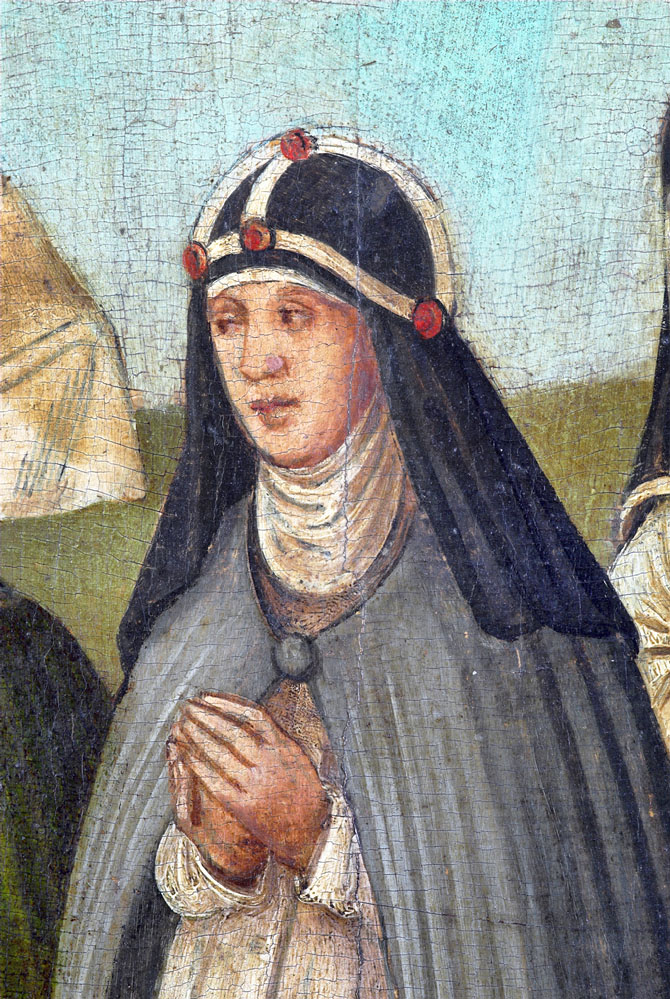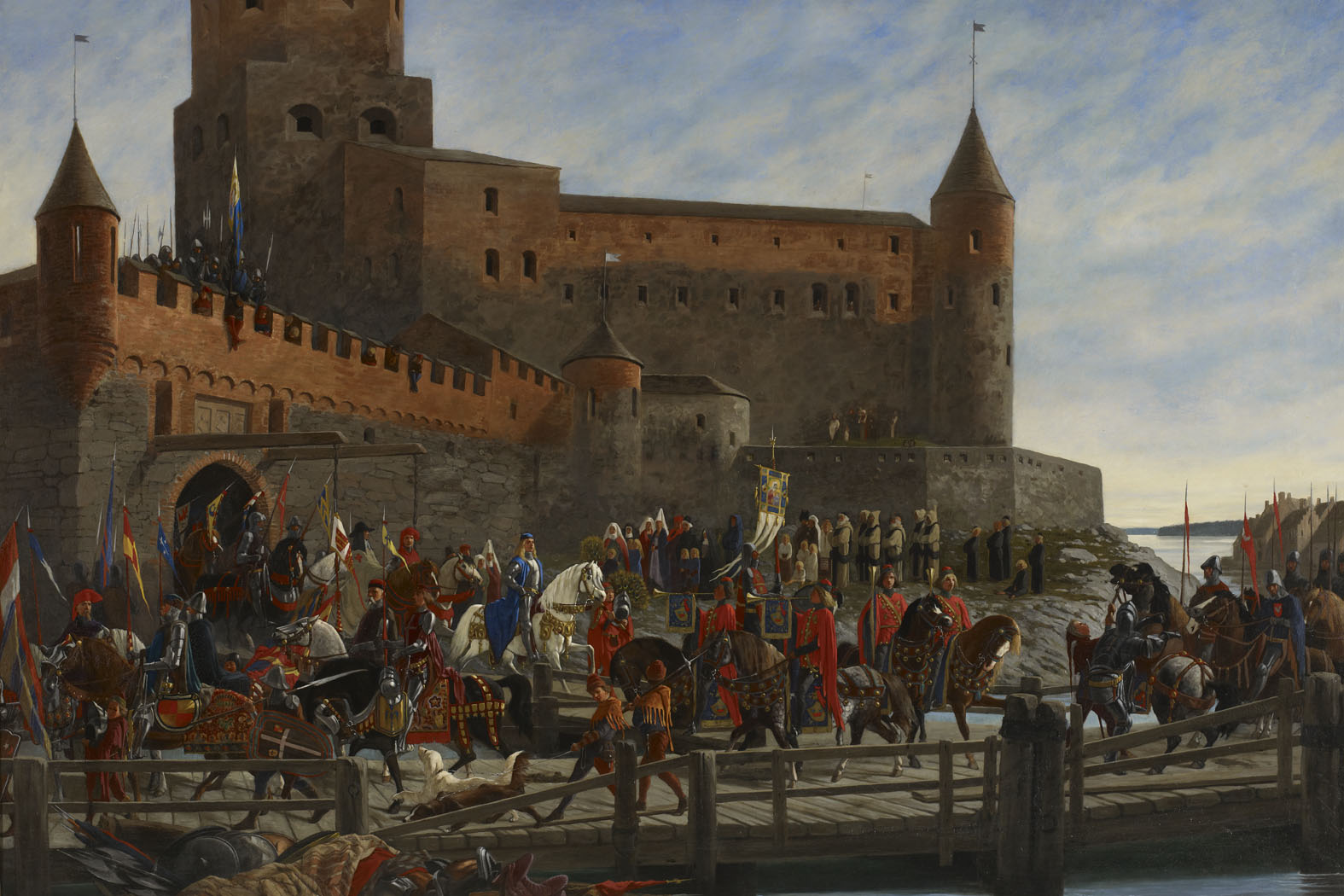|
Ingeborg Of Holstein
Ingeborg of Holstein (1396 – 14 October 1465), was Abbess of Vadstena Abbey 1447-1452 and 1457-1465. She was the daughter of Gerhard VI, Count of Holstein-Rendsburg (d. 1404) and Catherine Elisabeth of Brunswick-Lüneburg. In 1408, she was placed in the convent by Queen Margaret I of Denmark by special consent of the Pope. She became a full member of the order in 1415. Due to her age, it is believed that she initially resided in her own house on the convent premises. In 1447, she was appointed Abbess. Her election was controversial and an active opposition remained against her appointment. She had the loyal support of the confessor of the abbey, Magnus Unnonis. Ingeborg was the maternal aunt of King Christian I of Denmark, which was likely the cause to why King Charles VIII of Sweden 25 April 1452 demanded that she and the confessor of the abbey, Magnus Unnonis, should be deposed. Bishop Nils König of Linköping saw no cause for this, but both Ingeborg and Unnonis stepped down ... [...More Info...] [...Related Items...] OR: [Wikipedia] [Google] [Baidu] |
Abbess
An abbess (Latin: ''abbatissa''), also known as a mother superior, is the female superior of a community of Catholic nuns in an abbey. Description In the Catholic Church (both the Latin Church and Eastern Catholic), Eastern Orthodox, Coptic and Anglican abbeys, the mode of election, position, rights, and authority of an abbess correspond generally with those of an abbot. She must be at least 40 years old and have been a nun for 10 years. The age requirement in the Catholic Church has evolved over time, ranging from 30 to 60. The requirement of 10 years as a nun is only eight in Catholicism. In the rare case of there not being a nun with the qualifications, the requirements may be lowered to 30 years of age and five of those in an "upright manner", as determined by the superior. A woman who is of illegitimate birth, is not a virgin, has undergone non-salutory public penance, is a widow, or is blind or deaf, is typically disqualified for the position, saving by permission of ... [...More Info...] [...Related Items...] OR: [Wikipedia] [Google] [Baidu] |
Linköping
Linköping () is a city in southern Sweden, with around 105,000 inhabitants as of 2021. It is the seat of Linköping Municipality and the capital of Östergötland County. Linköping is also the episcopal see of the Diocese of Linköping (Church of Sweden) and is well known for its cathedral. Linköping is the center of an old cultural region and celebrated its 700th anniversary in 1987. Dominating the city's skyline from afar is the steeple of the cathedral, Domkyrka. Nowadays, Linköping is known for its university and its high-technology industry. Linköping wants to create a sustainable development of the city and therefore plans to become a carbon-neutral community by 2025. Located on the Östergötland Plain, Linköping is closely linked to Norrköping, roughly to the east, near the sea. History The city is possibly named after the '' Lionga ting'' assembly which according to Medieval Scandinavian laws was the most important thing in Östergötland. Exact l ... [...More Info...] [...Related Items...] OR: [Wikipedia] [Google] [Baidu] |
Bridgettine Nuns
The Bridgettines, or Birgittines, formally known as the Order of the Most Holy Savior (; abbreviated OSsS), is a monastic religious order of the Catholic Church founded by Saint Birgitta or Bridget of Sweden in 1344, and approved by Pope Urban V in 1370. They follow the Rule of Saint Augustine. There are today several different branches of Bridgettines. History The first monastery of the order was founded in 1369 at the former royal castle of Vadstena. St. Bridget's granddaughter, Lady Ingegerd Knutsdotter, was Abbess of Vadstena from 1385 to 1403. Upon her death on 14 September 1412, direct descent from St. Bridget became extinct. This opened the medieval concept of "Bridget's spiritual children", members of the order founded by her, to be her true heirs. The order spread widely in Sweden and Norway, and played a remarkable part in promoting culture and literature in Scandinavia; to this is to be attributed the fact that the motherhouse at Vadstena, by Lake Vättern, was not ... [...More Info...] [...Related Items...] OR: [Wikipedia] [Google] [Baidu] |
1396 Births
Year 1396 ( MCCCXCVI) was a leap year starting on Saturday (link will display the full calendar) of the Julian calendar. Events January–December * May 19 – Martin I succeeds his brother, John I, as King of Aragon (modern-day northeastern Spain). * July 20 – Queen Margaret I of Denmark, Norway and Sweden publishes the Treaty of Kalmar, proposing the personal union of the three kingdoms of Denmark, Norway (with Iceland, Greenland, the Faroe Islands, Shetland and Orkney) and Sweden (including Finland and Åland). * July 23 – Queen Margaret makes her great-nephew and adopted son Eric of Pomerania joint ruler of Sweden. Eric has already been made joint ruler of Norway. * September – Battle of the North Inch ("Battle of the Thirty"): In a mass trial by combat on the North Inch of Perth, Scotland, the Clan Cameron defeats the Clan Mackintosh. * September 19 – Duke of Brittany John V marries Joan of France. * September 25 &ndas ... [...More Info...] [...Related Items...] OR: [Wikipedia] [Google] [Baidu] |
1465 Deaths
Year 1465 ( MCDLXV) was a common year starting on Tuesday (link will display the full calendar) of the Julian calendar. Events January–December * January 24 – Chilia is conquered by Stephen the Great of Moldavia, following a second siege. * January 29 – Amadeus IX becomes Duke of Savoy. * January 30 – Charles VIII of Sweden is deposed. Clergyman Kettil Karlsson Vasa becomes Regent of Sweden. * c. March – Queens' College, Cambridge, is refounded by Elizabeth Woodville. * July 16 – Battle of Montlhéry: Troops of King Louis XI of France fight inconclusively against an army of great nobles, organized as the League of the Public Weal. * July 18 – Former King Henry VI of England is captured by Yorkist forces. On July 24 he is imprisoned in the Tower of London. His queen consort Margaret of Anjou and Edward of Westminster, Prince of Wales, have fled to France. * August 11 – In Sweden, Regent Kettil Karlsson Vasa, Bishop of Linkö ... [...More Info...] [...Related Items...] OR: [Wikipedia] [Google] [Baidu] |
Europäische Stammtafeln
''Europäische Stammtafeln'' - German for ''European Family Trees'' - is a series of twenty-nine books which contain sets of genealogical tables of the most influential families of Medieval European history. It is a standard reference work for those researching medieval, imperial, royal and noble families of Europe. A reference to this work is usually to the third series. A fourth series, identified as ''Neue Folge'', was being written by Rev. Detlev Schwennicke who was the sole author who started at volume 17 and is currently being published Frankfurt am Main, by Verlag Vittorio Klostermann. Twenty-nine volumes are available. Detlev Schwennicke died on 24 December 2012.John P. DuLong, Ph.D''Europäische Stammtafeln'' Notes/ref> History The preceding 16 volumes of the third series of the Europäische Stammtafeln (edited by Detlev Schwennicke) was a derivative work which built on the contributions of: * the first series edited by Wilhelm Karl, Prinz zu Isenburg (1903–1956). He p ... [...More Info...] [...Related Items...] OR: [Wikipedia] [Google] [Baidu] |
Conciliarism
Conciliarism was a reform movement in the 14th-, 15th- and 16th-century Catholic Church which held that supreme authority in the Church resided with an ecumenical council, apart from, or even against, the pope. The movement emerged in response to the Western Schism between rival popes in Rome and Avignon. The schism inspired the summoning of the Council of Pisa (1409), which failed to end the schism, and the Council of Constance (1414–1418), which succeeded and proclaimed its own superiority over the Pope. Conciliarism reached its apex with the Council of Basel (1431–1449), which ultimately fell apart. The eventual victor in the conflict was the institution of the papacy, confirmed by the condemnation of conciliarism at the Fifth Lateran Council, 1512–17. The final gesture, the doctrine of papal infallibility, was not promulgated until the First Vatican Council of 1870. Conciliar theory William of Ockham (d. 1349) wrote some of the earliest documents outlining th ... [...More Info...] [...Related Items...] OR: [Wikipedia] [Google] [Baidu] |
Marinus De Fregeno '', a serial in the ''Doctor Who'' TV series
{{disambig ...
Marinus may refer to: *Marinus (crater), a crater on the Moon *Marinus (given name), for people named Marinus *Dr. Marinus, a recurring character in the novels of David Mitchell See also *''The Keys of Marinus ''The Keys of Marinus'' is the fifth serial in the British science fiction television series '' Doctor Who'', which was first broadcast on BBC TV/BBC1 in six weekly parts from 11 April to 16 May 1964. Written by Terry Nation and directed by Joh ... [...More Info...] [...Related Items...] OR: [Wikipedia] [Google] [Baidu] |
Nils König
Nils is a Scandinavian given name, a chiefly Norwegian, Danish, Swedish and Latvian variant of Niels, cognate to Nicholas. People and animals with the given name * Nils Bergström (born 1985), Swedish ice hockey player *Nils Björk (1898–1989), Swedish Army lieutenant general *Nils Dacke (died 1543), Swedish rebel *Nils-Joel Englund (1907–1995), Swedish cross-country skier *Nils Ericson (1802–1870), Swedish inventor and engineer *Nils Frahm (born 1982), German pianist and producer *Nils Frykdahl, American musician *Nils Gründer (born 1997), German politician * Nils Hald (1897–1963), Norwegian actor *Nils Haßfurther (born 1999), German basketball player *Nils-Göran Holmqvist (born 1943), Swedish politician *Nils Kreicbergs (born 1996), Latvian handball player *Nils Liedholm (1922–2007), Swedish footballer and coach *Nils Lofgren (born 1951), American musician * Nils Lorens Sjöberg (1754-1822), Swedish officer and poet *Nils Mittmann (born 1979), German basketball play ... [...More Info...] [...Related Items...] OR: [Wikipedia] [Google] [Baidu] |
Vadstena Abbey
The Abbey Pax Mariae ( la, Monasterium sanctarum Mariæ Virgìnis et Brigidæ in Vatzstena), more commonly referred to as Vadstena Abbey, situated on Lake Vättern in the Diocese of Linköping, Sweden, was the motherhouse of the Bridgettine Order. The abbey started on one of the farms donated to it by the king, but the town of Vadstena grew up around it. It was active from 1346 until 1595. History Foundation and duration The abbey was founded in 1346 by Saint Bridget with the assistance of King Magnus IV of Sweden and his Queen Blanche, who made a will donating ten farms, including that of Vadstena in Dal Hundred, Östergötland, to the abbey founded by Bridget. The daughter of Saint Bridget, Saint Catherine, on arriving there in 1374 with the relics of her mother, found only a few novices under a Religious Superior. They chose Catherine as their abbess. She died in 1381, and it was not until 1384 that the abbey was blessed by the Bishop of Linköping. The first r ... [...More Info...] [...Related Items...] OR: [Wikipedia] [Google] [Baidu] |
Bishop
A bishop is an ordained clergy member who is entrusted with a position of authority and oversight in a religious institution. In Christianity, bishops are normally responsible for the governance of dioceses. The role or office of bishop is called episcopacy. Organizationally, several Christian denominations utilize ecclesiastical structures that call for the position of bishops, while other denominations have dispensed with this office, seeing it as a symbol of power. Bishops have also exercised political authority. Traditionally, bishops claim apostolic succession, a direct historical lineage dating back to the original Twelve Apostles or Saint Paul. The bishops are by doctrine understood as those who possess the full priesthood given by Jesus Christ, and therefore may ordain other clergy, including other bishops. A person ordained as a deacon, priest (i.e. presbyter), and then bishop is understood to hold the fullness of the ministerial priesthood, given responsibil ... [...More Info...] [...Related Items...] OR: [Wikipedia] [Google] [Baidu] |
Charles VIII Of Sweden
Charles VIII ( sv, Karl; 1408–1470), contemporaneously known as Charles II and called Charles I in Norwegian context, was king of Sweden (1448–1457, 1464–1465 and 1467–1470) and king of Norway (1449–1450). Regnal name Charles was the second Swedish king by the name of Charles (Karl). ''Charles VIII'' is a posthumous invention, counting backwards from Charles IX (r. 1604–1611) who adopted his numeral according to a fictitious history of Sweden. Six others before Charles VII are unknown to any sources before Johannes Magnus's 16th century book ', and are considered his invention. Charles was the first Swedish monarch of the name to actually use a regnal number as ''Charles II'' (later retrospectively renumbered VIII), on his wife's tombstone (1451) at Vadstena. Early life Karl Knutsson was born in October 1408 or 1409, at Ekholmen Castle, the son of Knut Tordsson ( Bonde), knight and member of the privy council (''riksråd''), and Margareta Karlsdotter (Sparre av ... [...More Info...] [...Related Items...] OR: [Wikipedia] [Google] [Baidu] |




